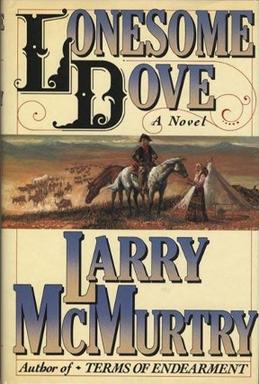
Lonesome Dove is a 1985 Western novel by American writer Larry McMurtry. It is the first published book of the Lonesome Dove series and the third installment in the series chronologically. It was a bestseller and won the 1986 Pulitzer Prize for Fiction. In 1989, it was adapted as a TV miniseries starring Tommy Lee Jones and Robert Duvall, which won both critical and popular acclaim. McMurtry went on to write a sequel, Streets of Laredo (1993), and two prequels, Dead Man's Walk (1995) and Comanche Moon (1997), all of which were also adapted as TV series.
The Lonesome Dove series is a series of four western fiction novels written by Larry McMurtry and the five television miniseries and television series based upon them.

Larry Jeff McMurtry was an American novelist, essayist, and screenwriter whose work was predominantly set in either the Old West or contemporary Texas. His novels included Horseman, Pass By (1962), The Last Picture Show (1966), and Terms of Endearment (1975), which were adapted into films. Films adapted from McMurtry's works earned 34 Oscar nominations. He was also a prominent book collector and bookseller.
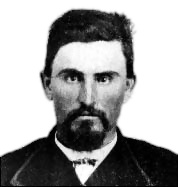
Charles Goodnight, also known as Charlie Goodnight, was a rancher in the American West. In 1955, he was inducted into the Hall of Great Westerners of the National Cowboy & Western Heritage Museum.
John Joel Glanton was an early settler of Arkansas Territory. He was also a Texas Ranger and a soldier in the Mexican–American War, and the leader of a notorious gang of scalp-hunters in Northern Mexico and the Southwestern United States during the mid-19th century. Contemporary sources also describe him as a murderous outlaw and prominent participant in the Texas Revolution. He appears as a violent figure in the works of the prominent Western writers Larry McMurtry and Cormac McCarthy.

Oliver Loving was an American rancher and cattle driver. Together with Charles Goodnight, he developed the Goodnight-Loving Trail. He was mortally wounded by Native Americans while on a cattle drive.

Comanche Moon (1997) is a western novel by American writer Larry McMurtry. It is the fourth and final book he published in the Lonesome Dove series. In terms of chronology, it is the second installment of the narrative. A Comanche Moon in Texas history was a full moon in autumn which permitted Comanche warriors to ride by night journeying southward to raid Mexico for livestock and captives.

The Comanche Wars were a series of armed conflicts fought between Comanche peoples and Spanish, Mexican, and American militaries and civilians in the United States and Mexico from as early as 1706 until at least the mid-1870s. The Comanche were the Native American inhabitants of a large area known as Comancheria, which stretched across much of the southern Great Plains from Colorado and Kansas in the north through Oklahoma, Texas, and eastern New Mexico and into the Mexican state of Chihuahua in the south. For more than 150 years, the Comanche were the dominant native tribe in the region, known as “the Lords of the Southern Plains”, though they also shared parts of Comancheria with the Wichita, Kiowa, and Kiowa Apache and, after 1840, the southern Cheyenne and Arapaho.

Streets of Laredo is a 1993 Western novel by American writer Larry McMurtry. It is the second book published in the Lonesome Dove series, but the fourth and final book chronologically. It was adapted into a television miniseries in 1995.
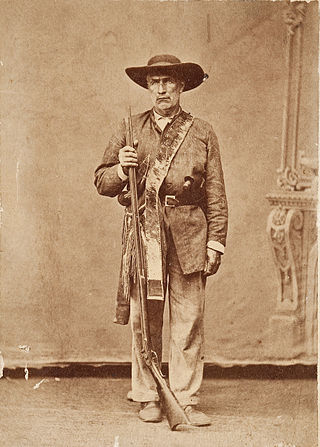
William Alexander Anderson "Bigfoot" Wallace was a Texas Ranger who took part in many of the military conflicts of the Republic of Texas and the United States in the 1840s, including the Mexican–American War.
Buffalo Hump was a War Chief of the Penateka band of the Comanches. He came to prominence after the Council House Fight when he led the Comanches on the Great Raid of 1840.
The Texan Santa Fe Expedition was a commercial and military expedition in 1841 by the Republic of Texas with the objective of competing with the lucrative trade conducted over the Santa Fe Trail and the ulterior motive of annexing to Texas the eastern one-half of New Mexico, then a province of Mexico. The expedition was unofficially initiated by the president of Texas, Mirabeau B. Lamar. The initiative was a major component of Lamar's ambitious plan to turn the fledgling republic into a continental power, which the president believed had to be achieved as quickly as possible to stave off the growing movement demanding the annexation of Texas to the United States. Lamar's administration had already started courting the New Mexicans, sending out a commissioner in 1840. Many Texans believed that the New Mexicans would be favorable to the idea of joining the Republic of Texas.
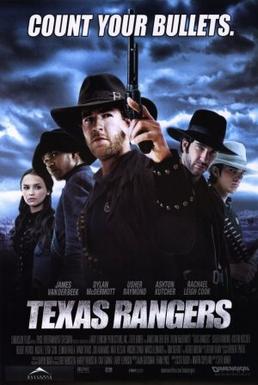
Texas Rangers is a 2001 American action Western film directed by Steve Miner and starring James Van Der Beek, Ashton Kutcher, Alfred Molina, and Dylan McDermott. It follows a group of Texas Rangers in the post-American Civil War era. The film is very loosely based upon the book Taming the Nueces Strip by George Durham, who based it on his own experiences serving in Captain Leander McNelly's Texas Ranger group as a young man. The film was panned by critics and was a box office bomb.

Comanche Moon is a 2008 American Western television miniseries, an adaptation of the 1997 novel of the same name. Woodrow Call and Gus McCrae are in their middle years, serving as Texas Rangers. In terms of the Lonesome Dove series' storyline, this account serves as a prequel to the Lonesome Dove miniseries, and a sequel to Dead Man's Walk. It first aired on CBS beginning Sunday, January 13, and continuing Tuesday, January 15, and Wednesday, January 16, 2008.
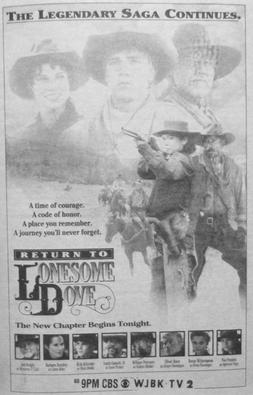
Return to Lonesome Dove is a 1993 American four part television miniseries, written by John Wilder involving characters created in Larry McMurtry's Western novel Lonesome Dove which was broadcast by CBS and first aired on November 14–17, 1993. The story focuses on a retired Texas Ranger and his adventures driving mustangs from Texas to Montana. It was nominated for an Emmy Award, and followed by Lonesome Dove: The Series.

Lonesome Dove is a 1989 American epic Western adventure television miniseries directed by Simon Wincer. It is a four-part adaptation of the 1985 novel of the same name by Larry McMurtry and is the first installment in the Lonesome Dove series. The novel was based upon a screenplay by Peter Bogdanovich and McMurtry. The miniseries stars an ensemble cast headed by Robert Duvall as Augustus McCrae and Tommy Lee Jones as Woodrow Call. The series was originally broadcast by CBS from February 5 to 8, 1989, drawing a huge viewing audience, earning numerous awards, and reviving both the television Western and the miniseries.
Larry McMurtry's Streets of Laredo is a 1995 American Western television miniseries directed by Joseph Sargent. It is a three-part adaptation of the 1993 novel of the same name by author Larry McMurtry and is the third installment in the Lonesome Dove series serving as a direct sequel to Lonesome Dove (1989), ignoring the events of Return to Lonesome Dove (1993). The series is set in the 1890s.

Bose Ikard was an African-American cowboy who participated in the pioneering cattle drives on what became known as the Goodnight–Loving Trail, after the American Civil War and through 1869. Aspects of his life inspired the fictional character Joshua Deets, the African-American cowboy in Larry McMurtry's novel Lonesome Dove.
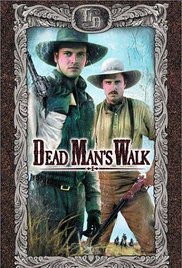
Dead Man's Walk is an American epic Western adventure television miniseries starring David Arquette as Augustus McCrae and Jonny Lee Miller as Woodrow F. Call. It was directed by Yves Simoneau. It is a two-part adaptation of the 1995 novel of the same name by Larry McMurtry and is chronologically the third book of the Lonesome Dove series, but regarded as the first events in the Lonesome Dove franchise. In this prequel to Lonesome Dove, it is 1840s Texas, and two young men join the Texas Rangers unit that's on a mission to annex Santa Fe. While the miniseries has been broken up into 3 parts for the DVD release, the series was originally broadcast by ABC over two nights in May 1996, and was later nominated for several awards.
Yellow Wolf, Spirit Talker 's nephew and Buffalo Hump 's cousin and best support, was a War Chief of the Penateka division of the Comanche Indians. He came to prominence after the Council House Fight, when Buffalo Hump called the Comanches and, along with Yellow Wolf and Santa Anna, led them in the Great Raid of 1840.














